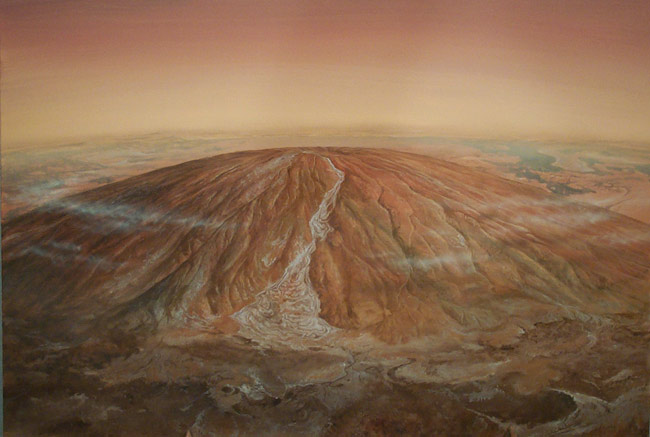Titan's Ice Volcanoes Might Produce Stuff of Life

For almostthirty years, scientists have known that complex carbon compounds calledtholins exist on comets and in the atmospheres of the outer planets.Theoretically, tholins might interact with water in a process called hydrolysisto produce complex molecules similar to those found on the early Earth.
On theEarth, complex organic molecules are believed to have been an early step in theemergenceof life; such compounds are called prebiotic.
Titan, thesixth and largest moon of the planet Saturn, is thought to be made largely ofice. Some of that ice may melt during meteor impacts or in undergroundprocesses, producing "ice volcanoes" that emit a "lava"containing ammonia mixed with water.
Could tholinsformed in Titan'satmosphere react with liquid water temporarily exposed by meteor impacts orice volcanoes to produce potentially prebiotic complex organic molecules — beforethe water freezes? Until this year, no one knew.
Into thelab
Now,laboratory research by Catherine Neish, a graduate student working on herdoctorate in planetary science at the University of Arizona, shows in thejournal Astrobiology that, over a period of days, compounds similar totholins can be hydrolyzed (which means to react with water) at near-freezingtemperatures.
Liquidwater exposed on Titanis believed to persist for hundreds to thousands of years — plenty of time forsuch reactions to take place.
Breaking space news, the latest updates on rocket launches, skywatching events and more!
Tantalizingly,it has been suggested that a similar process may have happened on the earlyEarth.
In her lab,Neish created organic compounds similar to tholinsby subjecting a mixture of 5 percent methane and 95 percent nitrogen toelectrical discharge at a low temperature (-108 degrees F or -78 degrees C). She dissolvedsamples of the resulting material in water, and then, at a range oftemperatures from freezing up to 104 degrees F (40 degrees C), measured the rate at which themixture hydrolyzed.
Neish foundthat up to 10 percent of the organic compounds she began with reacted withoxygen from the water to form complexorganic molecules.
While Neish'swork was judged worthy of publication in a scientific journal, she has somecritics. James P. Ferris, a research professor at Rensselaer PolytechnicInstitute University, who has studied the chemistry of Titan's atmosphere formany years, calls her work "flawed" because she used an electricdischarge to generate tholins, while those in Titan's atmosphere are probablygenerated by ultraviolet (UV) light and charged-particle radiation.
Ferris hasconducted experiments on a mixture of gases similar to Titan's atmosphere usingUV light and says, "The structures of the compounds made by [electric]discharge differ from those formed by UV photolysis so the hydrolysis timecould be very different.? Some of the photochemical products [when UV light isused] are hydrocarbons that do not react with water."
Neish respondsthat electric, or plasma, discharge "was meant to mimic charged particleinteractions (which Ferris admits is a process at work on Titan)." Sheagrees that "UV light radiation produces tholins that look more like Titan'shaze," but she points out that "some, if not most, of the products wemake also don't react with water."
She acknowledgesthat her work is not an ideal representation of chemistry in Titan's atmosphere:"Tholins formed at low pressure seem to 'look' more like Titan's haze thanthose formed at higher pressures. You can make tholins at low pressures usingUV light; you cannot make tholins at low pressure using plasma discharge. Andto make the amount of tholins we needed for the experiment, we needed to usethe discharge technique.? UV photolysis only produces small amounts."
More tocome
Ferris, whowas not aware of Neish's work until we contacted him, agrees that analyzing theresults of hydrolysis on samples produced by UV light would be "moredifficult because of the small samples formed."
Anotherissue is that Neish performed hydrolysis of her tholins in pure water, whileany water present on Titan is probably mixed with ammonia. She told us that sherecently completed another set of hydrolysis experiments using mixtures ofammonia and water, and expects to publish those results shortly.
While Neish'swork is not a perfect representation of chemistry on Saturn's largest moon, itnonetheless suggests that similar processes could produce organic compounds insignificant quantities during periods when liquid water is available.
On Titan,this suggests that prebiotic molecules might exist in meltwater from impactcraters and icevolcanoes. And similar processes might have occurred on the early Earth,before our atmosphere contained significant quantities of free oxygen.
- The Living Worlds Hypothesis
- Top 10 Most Intriguing Extrasolar Planets
- Titan's Face Lifted
